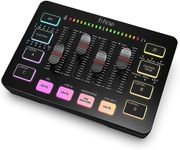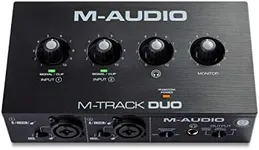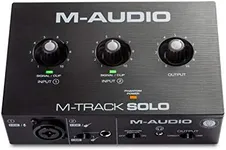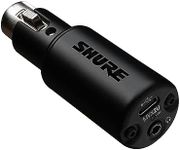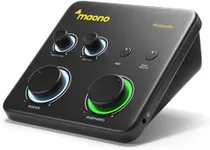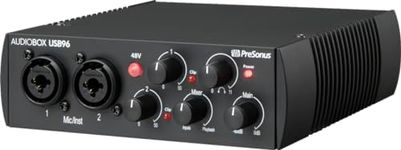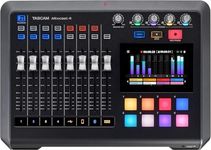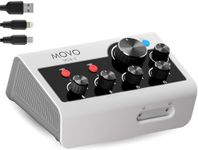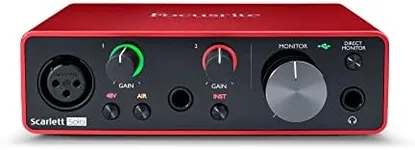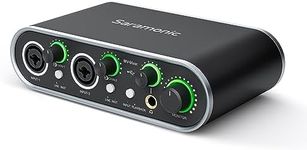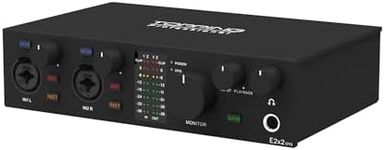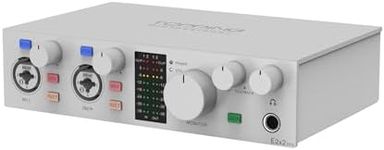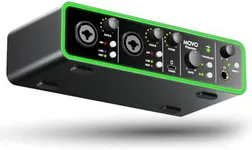Buying Guide for the Best Xlr Audio Interface
When choosing an XLR audio interface, it's important to consider your specific needs and how you plan to use the device. An XLR audio interface is a crucial piece of equipment for anyone looking to record high-quality audio, whether you're a musician, podcaster, or content creator. The right interface can make a significant difference in the clarity and quality of your recordings. Here are some key specifications to consider when selecting an XLR audio interface.Number of Inputs and OutputsThe number of inputs and outputs on an audio interface determines how many devices you can connect simultaneously. This is important because it affects your ability to record multiple sources at once. If you only need to record a single microphone or instrument, a simple interface with one or two inputs will suffice. However, if you plan to record a band or multiple instruments simultaneously, you'll need an interface with more inputs and outputs. Consider your recording needs and choose an interface that can accommodate them.
Phantom PowerPhantom power is a feature that supplies power to condenser microphones, which require an external power source to operate. This is important if you plan to use condenser microphones, as they are commonly used for their sensitivity and accuracy in capturing sound. When choosing an audio interface, ensure it has phantom power if you intend to use condenser microphones. Most interfaces will have a switch to turn phantom power on or off, so you can use both dynamic and condenser microphones.
Bit Depth and Sample RateBit depth and sample rate are measures of audio quality. Bit depth refers to the number of bits of information in each audio sample, while sample rate refers to the number of samples taken per second. Higher bit depths and sample rates result in better audio quality. Common bit depths are 16-bit and 24-bit, and common sample rates are 44.1kHz, 48kHz, and 96kHz. For most users, a 24-bit depth and a sample rate of 48kHz will provide excellent audio quality. However, if you require the highest possible quality for professional recordings, you may want to consider higher values.
LatencyLatency is the delay between the input of a sound and its output through the audio interface. Low latency is crucial for real-time monitoring and recording, as high latency can cause noticeable delays that disrupt the recording process. When choosing an audio interface, look for one with low latency to ensure smooth and accurate recordings. Many interfaces will advertise their latency performance, so compare these values to find one that meets your needs.
ConnectivityThe type of connectivity an audio interface offers determines how it connects to your computer or recording device. Common connection types include USB, Thunderbolt, and FireWire. USB interfaces are widely compatible and easy to use, making them a good choice for most users. Thunderbolt interfaces offer faster data transfer rates and lower latency, which can be beneficial for professional use. FireWire is less common but still used in some professional settings. Choose an interface with a connection type that is compatible with your computer and meets your performance needs.
Build Quality and PortabilityThe build quality and portability of an audio interface are important considerations, especially if you plan to use it in different locations or on the go. A well-built interface will be more durable and reliable over time. If you need to travel with your interface, look for a compact and lightweight model that is easy to transport. Consider the materials used in the construction and the overall design to ensure it meets your durability and portability requirements.
Software CompatibilitySoftware compatibility refers to how well the audio interface works with your digital audio workstation (DAW) and other recording software. This is important because it affects your ability to integrate the interface into your existing setup. Most interfaces are compatible with major DAWs, but it's always a good idea to check for any specific requirements or limitations. Additionally, some interfaces come with bundled software that can enhance your recording capabilities. Ensure the interface you choose is compatible with your preferred software and offers any additional features you may need.
